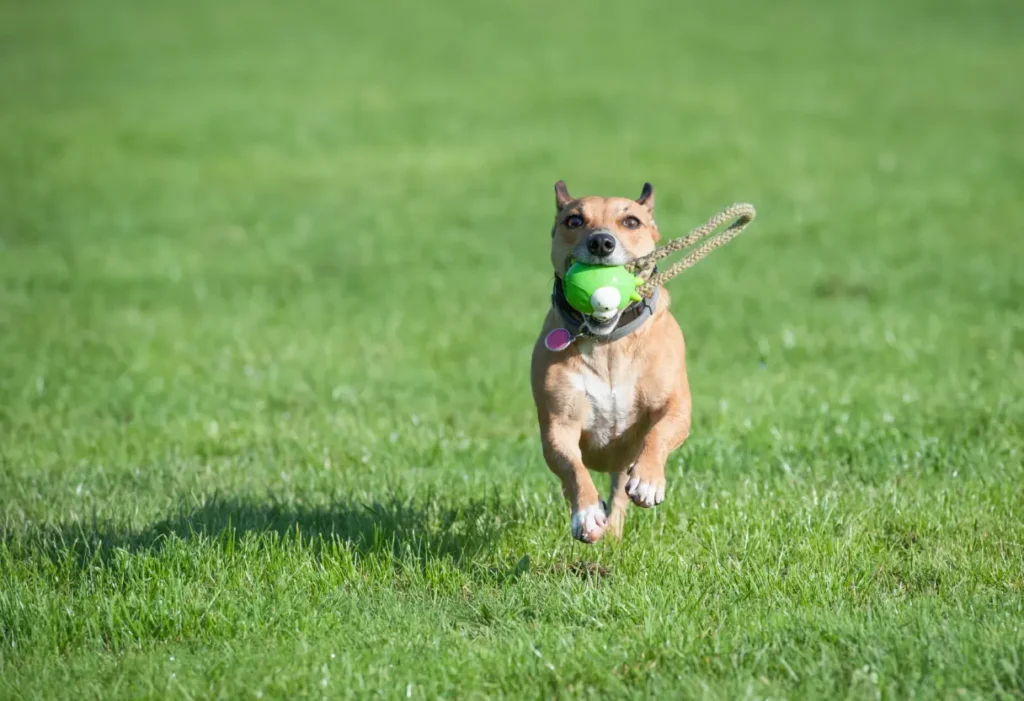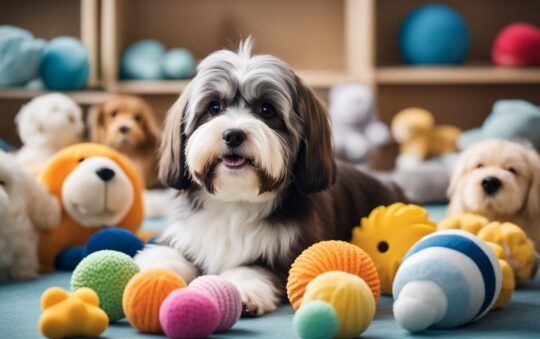Last updated on March 3rd, 2024 at 01:32 pm
“Why does my dog walk around holding a favorite toy?” Many pet owners ask this, seeking the best solution to understand their beloved pup’s behavior. This article dives into the reasons, revealing the deep-rooted instincts and desire to play that drive such activities.
Whether it’s a stuffed animal, a rubber toy, or a cherished ball, knowing why dogs engage with their toys the way they do can provide valuable insights into their needs and enhance their well-being.
| Key Takeaways: One reason your dog may walk around holding a toy is that they are seeking mental stimulation. By carrying a toy, they are finding a way to entertain themselves and alleviate boredom. Providing interactive toys or puzzle toys that require problem-solving can be an excellent solution to satisfy their desire for mental stimulation. |
Why do dogs carry and walk around with toys? Do these behaviors signify something deeper?
Dogs have their own unique ways of communicating with us, sometimes through their behavior toward toys. Let’s explore the reasons behind why dogs may carry and walk around with toys, and whether these behaviors signify something deeper.
Dogs carry toys to show affection or seek attention.
When your dog carries a toy, they might be signaling affection or seeking attention, essentially saying, “Let’s play!”
| Pro tip: Engage in playtime with your pup by tossing the toy for them to fetch or engaging in a game of tug-of-war. This will strengthen the bond between you and provide mental stimulation for your furry friend. |
Carrying toys can also be a form of comfort for dogs, providing them with a sense of security.
Dogs carry toys for comfort, just as humans find solace in familiar items
| Pro tip: Provide your dog with appropriate plush or stuffed toys that they can safely carry around. This will help alleviate any stress or anxiety they may be experiencing. |
Some dogs may carry toys to engage in play or as a means of self-soothing.
Some dogs show toys because they want to play. Others might do so to comfort themselves when stressed or bored.
| Pro tip: Keep an assortment of interactive toys, such as rope or rubber toys, that can keep your dog entertained and engaged. These toys are perfect for playtime and can help satisfy their natural instincts. |
Dogs may carry toys due to their ancestral instincts.
It’s important to remember that dogs have descended from wolves, who were hunters and scavengers. Even though our domesticated dogs may not need to hunt for their meals, they still retain certain instincts. Carrying objects in their mouths is a behavior deeply ingrained in their ancestry.
| Interesting fact: Some dog breeds, like retrievers and spaniels, have a strong instinct to carry objects in their mouths. This behavior was selectively bred into them over generations because it was useful for retrieving games during hunting expeditions. |
The psychology behind dogs’ attachment to their favorite toys
Dogs, like humans, form attachments to their favorite toys, finding comfort and reduced anxiety in their familiar scent and texture.
Table: Reasons Dogs Walk Around Holding Toys
| Reason & Behavior | Explanation & Activity |
|---|---|
| Mental Stimulation | Dogs need mental exercise. Playing with their favorite toy offers engagement and challenge. Whether it’s figuring out a treat puzzle or a game of tug-of-war with a rope toy, it’s perfect for their cognitive skills. |
| Instinctual Behavior | When your dog carries a toy, it mirrors their ancestral instinct to carry objects. This is deeply ingrained in their wolf lineage, indicating he is still driven by this instinct. |
| Breed-Specific Tendencies | According to experts, some dog breeds have natural inclinations. For example, retrievers were bred for retrieving, hence their desire to carry things. On the other hand, herding breeds might hold toys due to herding instincts. |
| Attachment and Dependency | If your dog seems too attached or shows distress when separated from his favorite toy, it’s a good idea to consult a veterinarian or animal behaviorist. |
Understanding why your dog behaves a certain way helps in ensuring they are content and well-cared for. It’s also imperative for pet owners to remember that this behavior is harmless unless it becomes obsessive or interferes with their daily activities.
Solutions for Excessive Toy Attachment
- Variety: Provide your dog with an assortment of pet toys to ensure he remains mentally stimulated. This will prevent him from becoming too attached to just one toy.
- Durable Choices: If you’re concerned about your dog’s toy being destroyed, consider durable options perfect for heavy chewing, such as rubber toys or chew bones.
Exploring the communication aspect of dogs carrying toys
Dogs can communicate with humans and other animals in many ways. One interesting behavior that dogs often exhibit is carrying toys around. This non-verbal form of communication can convey a dog’s desires or intentions, providing valuable insight into their needs and preferences.
Dogs Often Carry Toys to Indicate a Desire to Play or Interact.
When your dog holds a toy, it often means they want to play or interact with you or other pets. By carrying a toy, dogs are expressing their desire for fun and social engagement. They may bring their favorite stuffed animal or chew toy to you as an invitation to join in the playtime.
Paying Attention to Your Dog’s Cues is Important
As a dog owner, it’s crucial to notice these cues and react. Ignoring your dog’s request for play or interaction can lead to frustration and boredom. By recognizing their desire for engagement through toy-carrying behavior, you can strengthen your bond with your furry friend and provide them with the mental stimulation they need.
Understanding Why Dogs Carry Toys
Dogs carry toys for several reasons:
| Reason | Description |
|---|---|
| Instinctual Behavior | Dogs have an innate instinct to carry things due to their hunting roots. |
| Comfort & Security | Some dogs carry toys for a sense of comfort and security, especially when anxious. |
| Resource Guarding | Dogs may carry toys to protect them from threats or perceived competition. |
| Licking and Chewing | Allows dogs to satisfy their natural urges, helping to keep their teeth clean and healthy. |
Solutions for Encouraging Toy-Carrying Behavior
If your dog doesn’t naturally carry toys around, there are a few things you can try to encourage this behavior:
- Make Toys More Appealing: Ensure you have a variety of toys that are enticing and appealing to your dog. Experiment with different textures, shapes, and sizes to find what they enjoy the most.
- Attach Toys to Other Activities: Incorporate toy-carrying into other activities such as walks or playtime in the backyard. For example, attach a stuffed toy to their leash or bring a favorite toy along during outdoor adventures.
- Positive Reinforcement: Reward your dog with treats or praise when they carry their toys around. This positive reinforcement will reinforce the behavior and make it more likely for them to continue doing so.
Remember, every dog is unique, and what works for one may not work for another. It’s essential to observe your dog’s preferences and adjust accordingly.
What It Signifies If Your Dog Carries a Toy: Delving Deeper
A dog carrying a toy can indicate various things about their behavior and emotions. Let’s explore some possible reasons behind this intriguing canine habit.
Boredom or Desire for Mental Stimulation
One reason your dog may walk around holding a toy is that they are seeking mental stimulation. Dogs, just like humans, can get bored and need activities to keep their minds engaged. By carrying a toy, they are finding a way to entertain themselves and alleviate boredom. Providing interactive toys or puzzle toys that require problem-solving can be an excellent solution to satisfy their desire for mental stimulation.
Possessiveness over the Toy
Another possibility is that your dog feels possessive over the toy and wants to keep it close by. Dogs have instincts that drive them to protect their belongings, much like how they would guard food or territory. When they carry around a toy, it could be their way of safeguarding it from potential threats or ensuring no one takes it away from them.
Instinctual Behavior from Wild Ancestors
Carrying objects in their mouths is an instinctual behavior inherited from dogs’ wild ancestors. In the wild, dogs would often carry prey back to their dens or nests as a means of survival. This instinct remains ingrained in domesticated dogs, even if they no longer rely on hunting for sustenance. So when your dog carries around a toy, he is still driven by this instinct to carry things in his mouth.
Attachment and Comfort
Dogs form attachments to certain items just like humans do with their favorite possessions. If your dog has a particular stuffed animal or favorite toy, they might carry it around as a source of comfort and security. It becomes like a security blanket for them, providing familiar scents and textures that make them feel safe and relaxed.
Seeking Playtime Opportunities
When your dog carries a toy, it often means they want to play. Dogs use various behaviors to communicate their desire to engage in play, and carrying a toy is one of them. It’s their way of signaling to you or other dogs that they are ready for some fun and interactive activities.
Adorable reasons behind female dogs whining and carrying toys

Maternal Instincts: Mimicking Caring for Puppies
Female dogs may whine while carrying toys as part of their maternal instincts. Just like human mothers, female dogs have a natural nurturing instinct, and this behavior is often seen as a way of mimicking caring for puppies. It’s incredibly adorable to witness your furry friend walking around with a stuffed animal or her favorite toy, expressing her innate desire to nurture and protect.
Nesting Behavior: Creating a Safe Space
Whining and carrying toys can also be a sign of nesting behavior in female dogs. This behavior indicates their desire to create a safe space where they feel secure and comfortable. It’s not uncommon for female dogs to gather their belongings, such as stuffed toys or blankets, and arrange them in a specific area. This nesting behavior is an instinctive response that helps them prepare for the arrival of potential offspring.
Hormonal Changes: Heat Cycles and Mating Season
This behavior may occur during heat cycles or when female dogs experience hormonal changes related to mating season. When in heat, female dogs change physically and behaviorally due to shifting hormones. Carrying toys while whining can be one way for them to cope with these changes and express their reproductive instincts.
Breed-Specific Traits: Genetic Ancestry
According to experts, certain dog breeds are more prone to exhibiting behaviors like whining while carrying toys than others. For example, some hunting breeds have been bred specifically for retrieving game or objects in their mouths. This genetic ancestry can contribute to your dog’s inclination toward holding onto objects or toys.
Playful Desires: The Need for Interaction
Your dog might carry toys because she wants playtime with you or other pets. Dogs are social animals that thrive on interaction and stimulation. Carrying toys around can be their way of initiating play or seeking attention from their human companions.
Solution: Ensuring Appropriate Toys and Playtime
To address a female dog whining with toys, ensure they have appropriate toys and enough playtime:
- Provide a variety of pet toys that cater to different textures, sizes, and functions.
- Remember to rotate the toys regularly to keep them appealing and prevent boredom.
- Consider interactive toys that require problem-solving or treat-dispensing for mental stimulation.
- Offer chew toys made from safe materials, such as rubber or plush, to satisfy her natural urge to chew.
- Engage in regular play sessions with your dog using balls, frisbees, or rope toys for physical exercise.
By providing your female dog with engaging toys and ample playtime, you can help fulfill her instincts and keep her happy and content.
Impact of dogs bringing you toys on reducing pollution
Responsible Toy Management and Waste Reduction
Dogs holding toys can promote eco-friendly behavior. By encouraging reuse and recycling of dog toys, we minimize environmental impact.
Encouraging sustainable toy options for dogs is an important step towards creating a cleaner and greener planet. Instead of buying new toys often, think of ways to make your dog’s current toys last longer. Repairing torn stuffed animals or replacing squeakers in their favorite toys can help reduce unnecessary waste.
Sustainable Toy Options for Dogs
Toys made from eco-friendly materials are becoming increasingly popular among pet owners who want to minimize their environmental footprint. Look for toys made from natural fibers such as organic cotton or hemp, which are biodegradable and renewable resources. These types of toys not only benefit the environment but also provide safe and non-toxic options for your furry friend.
Rubber toys are another great choice as they are durable, long-lasting, and easy to clean. They can withstand heavy chewing and are less likely to end up in landfills compared to plush or fabric toys. Some rubber toys are designed with treat compartments that stimulate mental engagement while reducing the need for excessive treats or snacks.
Promoting Reuse and Recycling
Instead of throwing away old or worn-out dog toys, consider repurposing them in creative ways. For example, you could turn an old stuffed animal into a bed for your pup by removing any small parts that may pose a choking hazard. This way, you give your dog a cozy spot to rest while giving a second life to a beloved toy.
If your dog has accumulated more toys than they know what to do with, consider donating them to local animal shelters or rescue organizations. Many pets waiting for their forever homes would greatly appreciate a new toy to keep them company and provide comfort during their stay.
Dogs’ perception of stuffed animals and walking around with their bed and toys
Dogs view stuffed animals uniquely, and their habits of walking with their bed and toys have specific reasons worth exploring.
Stuffed Animals as Comforting Companions
Stuffed animals can hold a special place in a dog’s heart. For many dogs, these plush toys provide comfort and simulate the feeling of companionship. Dogs may carry around their stuffed animals as a way to fulfill their desire to play or cuddle with another living being. It’s like having a constant companion by their side, even when humans are not available.
Creating Familiarity in New Surroundings
When dogs walk around with their bed and toys, it could be an indication that they are trying to create a familiar environment in new surroundings. Dogs are creatures of habit, and they seek comfort in the familiar. By bringing along their bed and toys, they are essentially carrying pieces of home with them wherever they go. This behavior helps them feel secure, especially when faced with unfamiliar places or situations.
Alleviating Stress and Anxiety
The presence of familiar objects like beds and toys can help alleviate stress or anxiety in dogs. These items provide a sense of security and familiarity, which can be particularly beneficial during times of change or uncertainty. Whether it’s moving to a new house or encountering new people or animals, having their beloved possessions nearby can offer dogs a sense of calmness and reassurance.
Instinctual Behavior
It is important to note that dogs’ instinctual behavior also plays a role in walking around holding objects such as toys. Dogs have an innate drive to carry things in their mouths due to their ancestral roots as hunters who would bring back prey to share with the pack. Even though domesticated dogs no longer need to hunt for survival, this instinct remains ingrained within them.
Solutions and Considerations
If your dog often carries toys or their bed, consider a few things. First, ensure that the objects they carry are safe and appropriate for them. Avoid small or sharp items that could pose a choking hazard or cause injury. Provide a variety of toys to keep them engaged and entertained.
If your dog becomes overly attached to specific items and shows signs of distress when separated from them, it may be helpful to gradually wean them off this behavior. Encourage other forms of play and interaction to redirect their focus away from constantly carrying objects.
Remember, every dog is unique, and their behaviors can vary. If you have concerns about your dog’s behavior or if it seems excessive or compulsive, consult with a veterinarian or professional trainer who can provide guidance tailored specifically to your furry friend’s needs.
Decoding the meaning behind your dog’s toy-carrying behavior
Dogs carry toys for reasons like comfort, possessiveness, or attention-seeking. Observing their behavior helps interpret their needs and emotions.
While some dogs carry toys simply because they enjoy it, others may do so as a way of finding security or relieving anxiety. It is important to pay attention to the specific circumstances surrounding this behavior to accurately decode its meaning. Remember that each dog is unique, and their motivations may vary.
In conclusion, to understand your dog’s toy-carrying, observe carefully and consider their needs. By understanding the underlying reasons behind this behavior, you can strengthen your bond with your canine companion and ensure their well-being.
Frequently Asked Questions (FAQs)
Dogs may have preferences or scents. Some toys may provide more comfort or stimulation than others. Dogs may form attachments to specific toys due to positive associations or experiences they’ve had with them.
Growling while carrying a toy can be a sign of possessiveness or resource guarding. This behavior indicates that your dog considers the toy valuable and wants to protect it. It’s essential to monitor these situations closely and consult with a professional trainer if the growling becomes aggressive.
To encourage your dog’s interest in toys, try offering different types of toys that cater to their preferences. Engage in interactive play sessions using the chosen toy and reward them with praise or treats when they show interest or interact positively with it.
Excessive toy-carrying behavior may indicate anxiety or compulsive tendencies in some cases. If your dog’s behavior becomes obsessive, interferes with their daily activities, or causes distress, it is advisable to consult with a veterinarian or animal behaviorist for further evaluation and guidance.
With proper training and positive reinforcement techniques, you can teach your dog to retrieve and carry specific items on command. This skill can be useful for various purposes such as fetching the newspaper or bringing you a specific object. Seek guidance from a professional dog trainer to ensure effective training methods.








